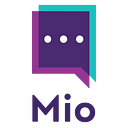Introducing Mio — Universal Messaging
The proliferation of real-time messaging in recent years has resulted in over 1,100 chat apps to choose from.
You probably have most of the top 10 installed on your phone: Facebook Messenger, Slack, WhatsApp, Snapchat, Twitter, LinkedIn, Telegram, Google Hangouts, WeChat, and Skype.
All of these services have one thing in common…
They’re all walled gardens.
Both the message sender and the receiver must be using the same application.
Today, we are launching Mio to solve this problem.
Mio is a universal messaging network that makes it easy to chat with anyone, regardless of which messaging app they use.
Users of popular workplace chat apps — such as Slack, Cisco Webex Teams, and Microsoft Teams — can use Mio to communicate with external vendors, partners and clients.
Mio supports sending direct messages to individual contacts or joining “universal channels,” which enable cross-platform group conversations across an unlimited number of organizations.
If you look back through human history, the communication technologies that have truly survived — email, telephone, video conferencing, etc — ultimately found their way to interoperability.
There’s no reason to think over-the-top messaging will be any different.
You only need to look back as far as CompuServe and Prodigy, or AIM and ICQ, to see what inevitably happens to closed online communities.
Fueled by the astronomical growth of Slack, team-based messaging platforms like Cisco Webex Teams and Microsoft Teams are radically improving the way people communicate in the office.
The fragmentation of enterprise messaging means, however, that most large enterprises use at least two messaging apps for internal communication.
A sales team using Webex Teams, for example, can’t chat directly with an engineering team using Slack.
Inevitably, the conversation defaults back to email or phone.
The same applies to external communications.
It shouldn’t be so difficult to send a message to your lawyer, your marketing agency, or your customers.
Switching between communication channels in the workplace is inefficient and saps productivity, and it doesn’t need to be this way.
Today, we are launching Mio for Slack, Webex Teams and Microsoft Teams, with the vision of adding additional platforms over the next year.
Start syncing your teams at www.m.io
Tom Hadfield is the Founder of Mio, a universal messaging startup based in Austin, Texas.
